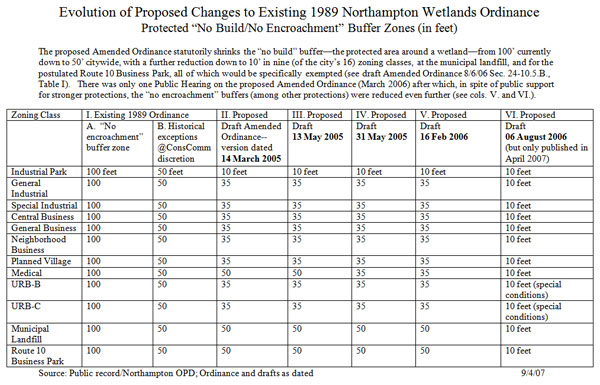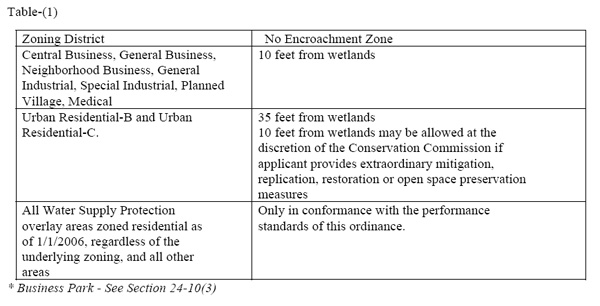It has been argued that the proposed wetlands ordinance merely codifies current practice with respect to buffer zones, so residents should not be unduly concerned. Ward 3 City Councilor Marilyn Richards goes further and maintains that the proposed ordinance is actually more restrictive than the current guidelines, but that some residents haven’t grasped this. “Because it’s so complicated, it’s very hard to understand,” she tells The Republican.
We disagree. We believe that the plain intent of the current wetlands ordinance, excerpted below, is to discourage development within 100 feet of wetlands. By contrast, the plain intent of the proposed wetlands ordinance is to encourage “infill” development to encroach as close to 10 feet to wetlands in downtown districts. When it comes down to how Conservation Commissions, Planning Boards, and the courts evaluate proposals, these intentions matter. That’s why numerous developers want the new ordinance and why many citizens oppose it.
Here is an excerpt from Northampton’s current wetlands ordinance, adopted in 1989:

Note: Public officials have given us to understand that at least one permit to encroach within 10 feet of wetlands has been issued in the Industrial Park district in recent years. Nevertheless, we believe that a 50-foot no-build buffer zone has been the more general rule.
See also:
Where We Stand on Wetlands: A Review of the Issues
The City Council should table the flawed wetlands ordinance until it has been revised to better reflect the people’s concern for our environment and the future health of our town.
The Wetlands Policy Lawsuit that City Officials Are Afraid Of
We can accept that Northampton should have its key wetlands policies specified by ordinance. However, we disagree that the city needs to lock itself into a buffer zone policy that’s about as weak as any we can find in the state, and at variance with Northampton’s Flood Mitigation Plan of 2004 and its Open Space Plan of 2005. A more balanced ordinance will better serve the long-term interests of the people. Springfield, for example, calls for a 50-foot no-touch buffer zone around wetlands.
We disagree. We believe that the plain intent of the current wetlands ordinance, excerpted below, is to discourage development within 100 feet of wetlands. By contrast, the plain intent of the proposed wetlands ordinance is to encourage “infill” development to encroach as close to 10 feet to wetlands in downtown districts. When it comes down to how Conservation Commissions, Planning Boards, and the courts evaluate proposals, these intentions matter. That’s why numerous developers want the new ordinance and why many citizens oppose it.
Here is an excerpt from Northampton’s current wetlands ordinance, adopted in 1989:
§ 337-2. Jurisdiction.Under the current ordinance, could the Conservation Commission permit developers to encroach to within zero feet of a wetland? Sure, but it would be in clear violation of the intent of the ordinance. Objectors would have a strong case in court. This is worlds apart from the proposed new ordinance, which positively invites developers to encroach within 10 feet of wetlands in several districts:
Except as permitted by the Conservation Commission or as provided in this chapter, no person shall remove, fill, dredge, build upon, or alter the following resource areas:
A. Any bordering vegetated wetland, freshwater wetland, riverine wetland, marsh, wet meadow, bog or swamp, or within 100 feet of said areas.
B. Any bank or beach, or within 100 feet of said areas.
C. Any lake, river, pond, or stream, whether intermittent or continuous, natural or man-made, or within 100 feet of said areas.
D. Any land under aforesaid waters.
E. Any land subject to flooding or inundation by groundwater, surface water, storm flowage, except artificially built detention areas and drainage channels including streets and gutters which would not otherwise be subject to jurisdiction under this chapter or 310 CMR, or within 40 feet of said areas subject to flooding or inundation.
F. Seasonal wetlands, isolated wetlands, including kettle holes, or within 100 feet of said areas.
To encourage infill development, which is considered more sustainable under the principals of smart growth and generally has a smaller environmental footprint than development in outlying areas, in the Central Business, General Business, Highway Business, Neighborhood Business, General Industrial, Special Industrial, Planned Village, Medical, Urban Residential-B and Urban Residential-C zoning districts, within those portions of the Water Supply Protection overlay district which was zoned industrial as of 1/1/2006, the Conservation Commission hereby waives any of the Section 24-10 performance standards that are over and above state law with the exception of the setback requirements in Table (1). The reduced setback requirements in Table (1) shall apply…The following chart makes clear that the proposed ordinance is not consistent with past practice, that it favors substantial new encroachments on Northampton’s wetlands, and that recent revisions have made it ever more lopsided in favor of developers:

Note: Public officials have given us to understand that at least one permit to encroach within 10 feet of wetlands has been issued in the Industrial Park district in recent years. Nevertheless, we believe that a 50-foot no-build buffer zone has been the more general rule.
See also:
Where We Stand on Wetlands: A Review of the Issues
The City Council should table the flawed wetlands ordinance until it has been revised to better reflect the people’s concern for our environment and the future health of our town.
The Wetlands Policy Lawsuit that City Officials Are Afraid Of
We can accept that Northampton should have its key wetlands policies specified by ordinance. However, we disagree that the city needs to lock itself into a buffer zone policy that’s about as weak as any we can find in the state, and at variance with Northampton’s Flood Mitigation Plan of 2004 and its Open Space Plan of 2005. A more balanced ordinance will better serve the long-term interests of the people. Springfield, for example, calls for a 50-foot no-touch buffer zone around wetlands.
